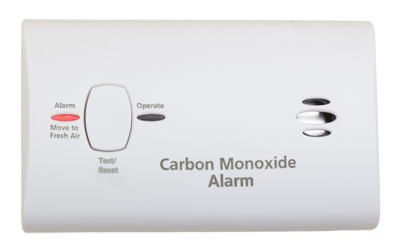Incorporate Safety for Comfort & Health
Minimize risks in your home by choosing appliances wisely for your specific site and needs. Follow through by relying on a professional for advice and expert installation that considers and incorporates safety at every step in the process.
Here are some common risks to be avoided:
Carbon monoxide

To prevent carbon monoxide poisoning, have a professional inspect all fuel-burning heating systems, including chimneys and flues, inside your home. Install and frequently monitor carbon monoxide detectors which should be used at all times in your home. More safety tips:
- Never burn charcoal or use camping cooking equipment inside your home
- Never leaving a car running inside the garage
- Never using fuel-powered tools or appliances indoors
If you seem to be experiencing any of the prolonged flu-like symptoms of CO poisoning including lightheadedness, get fresh air immediately. If you suspect a carbon monoxide buildup in your home, turn off appliances, open windows, leave the house, and call for help. Or, if your CO alarm is sounding, leave your home and call for help.
Mold
Molds are fungi that grow in nature as part of the process of decay. Indoors, molds grow when moisture is present. This can cause serious health problems, like allergies. Serious mold infestation can degrade the livability of your home. Left unchecked, extreme mold can render a home unlivable, requiring demolition. Mold should not be allowed to grow unchecked.
Consider the following tips for handling indoor mold:
- If mold affects an area of 10 square feet or more, hire a professional experienced in mold cleanup
- Seek professional recommendations if you have a health condition and you will be doing the cleanup yourself
- If you think your HVAC system may be contaminated with mold, consult EPA’s guide Should You Have the Air Ducts in Your Home Cleaned?. Do not run the HVAC system if you know or suspect that it is contaminated with mold because it could further spread mold throughout the building. Visit epa.gov/iaq/pubs/airduct.html, or call (800) 438-4318 for a free copy.
- If the water and/or mold damage was caused by sewage or other contaminated water, seek professional assistance
- Fix all leaks as soon as possible and dry everything thoroughly
- Scrub mold from hard surfaces with detergent and water and dry thoroughly
- Soft materials with mold may need to be discarded
- Avoid exposure to the greatest extent possible
- Do not paint or caulk over mold, and thoroughly wash and dry surfaces first
- Consult a specialist if you are not sure how to clean an item
- You may want to consider wearing a N-95 respirator from the hardware store, rubber gloves, and goggles when working where mold is present
- You will know that the mold has been removed when the odor is gone, the mold does not re-grow, and household members show no symptoms of mold exposure

The following tips will prevent mold growth:
- Vent appliances to the outdoors
- Use air conditioners and dehumidifiers when needed
- Run the bathroom fan and cooking fans to remove excess moisture
- Increase air temperature
- Clean your dehumidifier often and well
According to the EPA, the best way to control mold growth is to control moisture. For more information on mold-related issues, including mold cleanup and moisture control/condensation/humidity issues, you can call the EPA Indoor Air Quality Information Clearinghouse at (800) 438-4318. Click here to see the EPA’s Mold Resources page.